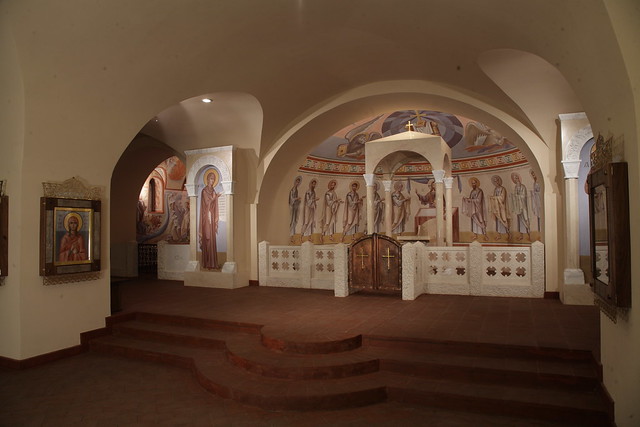The lower church was dedicated to the Orthodox Prince St. Alexander Nevsky and, perhaps, St. Mary Magdalene – the saints, bearing the same names as Emperor Alexander III and his wife Empress Maria Fedorovna. The side chapels were dedicated to St. Philaret and martyr Martha bearing the same names as Mikhail Fedorovich Romanov’s parents after they gave monastic vows.
The builders intended to imitate the style of Novgorod’s churches of the 13th century which remind of Alexander Nevsky’s time. The following statement was made in the report of the Building Committee in 1917:
“The middle altar of the lower church is constructed in honor of the Orthodox Prince St. Alexander Nevsky who lived in the 13th century. In ancient churches stone altar screens were used instead of iconostasis, that is why it was considered desirable by the Committee to erect a stone iconostasis screen in the lower church and also the altar, the credence table, the Crucifix and the tomb of the same material…”
The plan was never accomplished. Among all the archive photos and documents no single photo, sketch or drawing portraying the Lower church was founded.
Nowadays the lower church is decorated in accordance with the original creators’ designs and meets the modern liturgical needs of the Church. The renowned contemporary icon painter Archimandrite Zinon (Theodor) took over the general art design management of the lower church. The draft of the altar screen and frescoes in the altar apses proposed by him was approved by the Church Authority, the Board of Trustees, and supported by the authorities for the protection of a cultural heritage in St Petersburg. In addition to the murals, which father Zinon fulfilled himself, he and the iconographers recommended by him painted the icons for the lower church.

The altar apse of the LowerChurch.
Other photos of the Lower Church
The entire interior of the lower church corresponds with the main function of the Christian churches since ancient times- the Eucharistic celebration of the Church.
In the Central apse, where the Eucharist is celebrated on a stone throne under a marble canopy (tabernacle), the Eastern wall depicts the communion of the Apostles – which is a traditional scene, always placed in the centre of the iconostasis in each Orthodox church.
In the conch, above the canopy there are the characters of the four Evangelists: a man (Matthew), a lion (Mark), a calf (Luke) and an eagle (John). These biblical animals surround the etimacia (“the prepared Throne”) –a vacant Tsar’s throne, symbolizing the expectation of the coming of Christ.
Along the Eastern wall, under the frescos there are the clergy stalls and in the centre there is the Bishop’s throne. The altar area is separated from the main area by a low barrier with a purely functional value to indicate clearly the space for the altar and the deaconicon(place for deacons).
The side apses were given back the liturgical functions for which they were constructed in ancient times: in the Northern apse there is a credence table for prosthesis (the place for preparation) and in the Southern apse there is a deaconicon.
The purpose of the apses determined the subject of the murals.
The frescoes in the credence table present the Old Testament prototypes of Christ’s Calvary sacrifice and the Eucharist: “Sacrifice of Isaac” and “Abraham’s Meeting with Melchizedek”, “Theophany of the Burning Bush to Moses”, “Moses Receiving the Tablets of the Covenant” and “Excision by Moses of water from stone in the wilderness”.
In the deaconicon the events of the New Testament are depicted: deacons chosen for social service, according to the Book of the Acts of the Apostles. Apostle Paul is portrayed in two “images”: on the left – Saul, watching over the people who were pelting to death with stones Archdeacon Stephen, on the right – Paul, the apostle who wrote 14 epistles.
The piers between the altar and the side apses have also been decorated with frescoes framed by marble icon cases– the sacred images of the Savior on the right and of the Mother of God on the left. Both are portrayed full-length: our Savior with The Book (Gospel) in hand, the Virgin in praying posture with a scroll of prayer inscribed in Greek.
These images are the initial part of the Deesis, which was the прообраз of the iconostasis in the Orthodox churches for centuries.
Crucial to the decorations in the lower church are icons placed on the walls and pillars. All of them were painted with courtesy on the donations of parishioners and other benefactors.
Unusual sights in the lower church include the marble baptistery which has a crucial form for baptism of adults by full immersion, and the maze laid out in black and white marble on the floor in the center. It represents the human path to God. The maze imitates the maze of the Charters Cathedral (France), traditional to the churches in medieval Europe. The floor of the lower church consists of ceramic paving slabs, similar to those used to cover floors in Europe and in ancient Russia.

